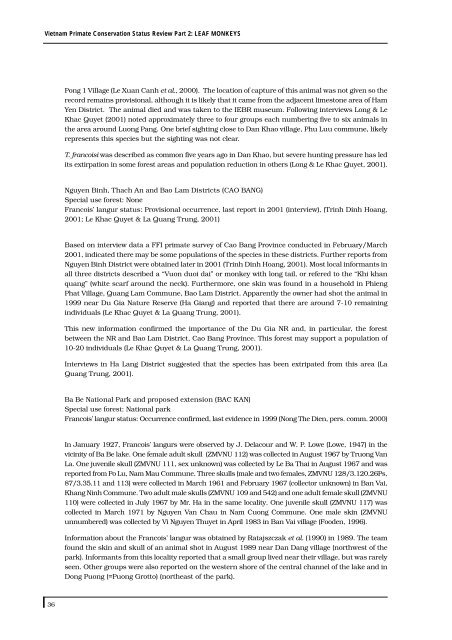Vietnam Primate Conservation Status Review 2002 - Hoang Lien ...
Vietnam Primate Conservation Status Review 2002 - Hoang Lien ...
Vietnam Primate Conservation Status Review 2002 - Hoang Lien ...
You also want an ePaper? Increase the reach of your titles
YUMPU automatically turns print PDFs into web optimized ePapers that Google loves.
<strong>Vietnam</strong> <strong>Primate</strong> <strong>Conservation</strong> <strong>Status</strong> <strong>Review</strong> Part 2: LEAF MONKEYS<br />
36<br />
Pong 1 Village (Le Xuan Canh et al., 2000). The location of capture of this animal was not given so the<br />
record remains provisional, although it is likely that it came from the adjacent limestone area of Ham<br />
Yen District. The animal died and was taken to the IEBR museum. Following interviews Long & Le<br />
Khac Quyet (2001) noted approximately three to four groups each numbering five to six animals in<br />
the area around Luong Pang. One brief sighting close to Dan Khao village, Phu Luu commune, likely<br />
represents this species but the sighting was not clear.<br />
T. francoisi was described as common five years ago in Dan Khao, but severe hunting pressure has led<br />
its extirpation in some forest areas and population reduction in others (Long & Le Khac Quyet, 2001).<br />
Nguyen Binh, Thach An and Bao Lam Districts (CAO BANG)<br />
Special use forest: None<br />
Francois’ langur status: Provisional occurrence, last report in 2001 (interview), (Trinh Dinh <strong>Hoang</strong>,<br />
2001; Le Khac Quyet & La Quang Trung, 2001)<br />
Based on interview data a FFI primate survey of Cao Bang Province conducted in February/March<br />
2001, indicated there may be some populations of the species in these districts. Further reports from<br />
Nguyen Binh District were obtained later in 2001 (Trinh Dinh <strong>Hoang</strong>, 2001). Most local informants in<br />
all three districts described a “Vuon duoi dai” or monkey with long tail, or refered to the “Khi khan<br />
quang” (white scarf around the neck). Furthermore, one skin was found in a household in Phieng<br />
Phat Village, Quang Lam Commune, Bao Lam District. Apparently the owner had shot the animal in<br />
1999 near Du Gia Nature Reserve (Ha Giang) and reported that there are around 7-10 remaining<br />
individuals (Le Khac Quyet & La Quang Trung, 2001).<br />
This new information confirmed the importance of the Du Gia NR and, in particular, the forest<br />
between the NR and Bao Lam District, Cao Bang Province. This forest may support a population of<br />
10-20 individuals (Le Khac Quyet & La Quang Trung, 2001).<br />
Interviews in Ha Lang District suggested that the species has been extripated from this area (La<br />
Quang Trung, 2001).<br />
Ba Be National Park and proposed extension (BAC KAN)<br />
Special use forest: National park<br />
Francois’ langur status: Occurrence confirmed, last evidence in 1999 (Nong The Dien, pers. comm. 2000)<br />
In January 1927, Francois’ langurs were observed by J. Delacour and W. P. Lowe (Lowe, 1947) in the<br />
vicinity of Ba Be lake. One female adult skull (ZMVNU 112) was collected in August 1967 by Truong Van<br />
La. One juvenile skull (ZMVNU 111, sex unknown) was collected by Le Ba Thai in August 1967 and was<br />
reported from Po Lu, Nam Mau Commune. Three skulls (male and two females, ZMVNU 128/3.120.26Ps,<br />
87/3.35.11 and 113) were collected in March 1961 and February 1967 (collector unknown) in Ban Vai,<br />
Khang Ninh Commune. Two adult male skulls (ZMVNU 109 and 542) and one adult female skull (ZMVNU<br />
110) were collected in July 1967 by Mr. Ha in the same locality. One juvenile skull (ZMVNU 117) was<br />
collected in March 1971 by Nguyen Van Chau in Nam Cuong Commune. One male skin (ZMVNU<br />
unnumbered) was collected by Vi Nguyen Thuyet in April 1983 in Ban Vai village (Fooden, 1996).<br />
Information about the Francois’ langur was obtained by Ratajszczak et al. (1990) in 1989. The team<br />
found the skin and skull of an animal shot in August 1989 near Dan Dang village (northwest of the<br />
park). Informants from this locality reported that a small group lived near their village, but was rarely<br />
seen. Other groups were also reported on the western shore of the central channel of the lake and in<br />
Dong Puong (=Puong Grotto) (northeast of the park).



